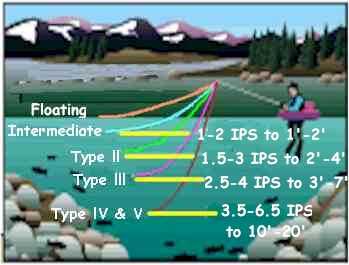|
Fly Line Sink Rates
Feeding fish change depths as they
react to changing conditions. Like people, they prefer to be "comfortable" in
their surroundings, where temperature, oxygen and sources of food are ideal. As fish seek out these
comfort zones, your most effective means of catching them is to "put your fly
where the fish are." The outline below shows the
general range of sink rates for fly lines for various "classes." These
include both floating/sinking (sinking tip) lines and full sinking lines. The
various fly line manufacturers vary these rates and the labels on their lines, but these
are representative.
|
|||
| Type | Sink Rate IPS (inches per second) |
Fishing Depth | General Use |
| class 1/ Intermediate |
1" to 2" | 1' - 2' | Ideal for trout, bass and panfish over shallow beds or just beneath the surface. |
| class 2 | 1.5" to 3" | 2' - 4' | Excellent general sinking line, especially for fishing lakes with shallow to medium depths. |
| class 3 | 2.5" to 4" | 3' - 7' | Quickly gets flies 3' to 7' deep. |
| class 4 | 3.5" to 6.5" | 10' - 15' | For deeper lakes and ocean-fishing. |
| class 5 | 4.5" to 6.5" | 15' - 20' | For deepest lakes, ocean fishing, fast moving streams |
| class 6 | 6" to 7" | 20' + | For fastest descent to deepest lake fishing; or slicing through rapid moving water |
| various | up to over 9" | to 20' + | Usually for heavy currents and very specialized deepest water approaches |
Some manufacturers also indicate the size of their sinking lines by stating their physical weight in grains; e.g., 175 grains to 625 grains, with the heavier/denser the weight in grains, the faster the sink rate. |
|||
